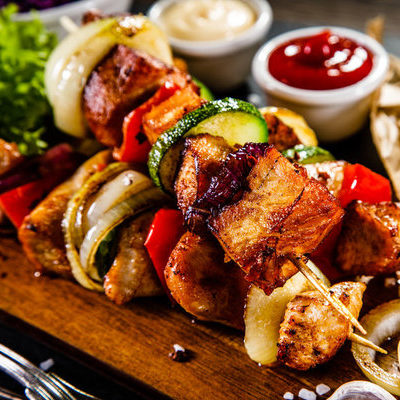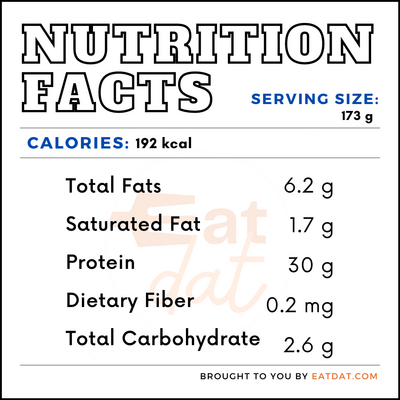
Kebabs
What are Kebabs?
Kebabs refer to dishes that are made of pieces of ground meat or fish and vegetables roasted on a skewer. This flavorful food is of Middle Eastern origin. There are many variants of kebabs all over the world. People can use any type of meat to make it, but mainly:
- lamb
- chicken
- goat
- beef
- pork
From 2014 to 2018, people between the ages of 11 and 18 in the UK ate 10g of burgers and kebabs per day.
The top ten types of kebab, according to Crazy Masala Food are:
- Murgh Palak Ke Korma Kebab
- Potato Mushroom Kebab
- Chatpatay Coconut Kebab
- Hara Masala Kebab
- Chakhle’s Shami Kebab
- Rajma Ke Kebab
- Pyazi Kebab
- Yogurt Kebab
- Shish Kebab
- Döner Kebab
Origin of kebabs
The interpretation of the word kebab is ‘to roast’. Kebabs have their roots in Asian and African cuisines and it is typical to serve them with rice and salad in Asian countries. Kebabs still feature in many dishes today with modern forms being served with bread. The origin of kebabs is believed to be in Turkey where soldiers grilled pieces of freshly hunted meats impaled on swords on open-field fires. The oldest document in which this dish was mentioned is a Turkish script from 1377.
Shish kebab is a popular dish in Arabia and is made up of pieces of marinated and grilled lamb meat. The marinade can include a concoction of lemon juice, olive oil, milk and yogurt, onion juice, cinnamon, tomato juice, and is often served with salad. Shish kebab is also known as Döner Kebab, which means ‘rotating kebab’. This variation of the dish dates back to the 1800s, during the Ottoman Empire in Turkey.
At the end of World War II, Turkish migrants brought kebabs to Europe, the US, and other parts of the Middle East. This dish is an important food for people in Pakistan as the citizens of this country consume different types of spicy kebabs. Today, many people consume this dish in different forms. It is now easily adaptable for both meat lovers and vegetarians.
Nutrition
In a 173g serving of chicken kebab, there are:

This dish can be a good source of nutrients. Here are three health benefits of chicken döner kebab:
- It can supply lean protein, which is vital for muscle growth.
- It contains vitamin B3, which reduces the risk of developing cancer.
- It boosts the body’s metabolism.
However, there are some health concerns associated with kebabs, which are outlined below:
- The spices and sauce from kebabs can affect your dental health.
- The food has a high-calorie content, which might be unsuitable for certain health conditions.
Application
Here are some tips to help you make the perfect kebab:
- If you are making your first kebab, use chicken meat, since it is easy to know when the meat is properly cooked.
- Cut your meat into optimal sizes of about 20g per piece.
- Ensure that the grill is already hot before you do anything on it.
If you want to store this dish’s leftovers, separate the meat from the vegetables, and refrigerate them. It is safe to reheat leftover kebabs the next day; however, it is not hygienic to reheat them a third time. If you reheat them a third time, the meat may have high levels of bacteria or lack taste. The best thing to do is to cook what will be enough for you in one meal. Also, you can also use a microwave, oven, or stove to store leftovers while waiting to reheat them.
Commercial production
The first step in the commercial production of kebab meat involves marinating the meat, minced meat, and fat for three to six hours. Next, the producer adds a spice mixture to the meat, which typically contains white pepper, thyme, black pepper, and cumin. This mixture can differ from one manufacturer to another. The following step is impaling the tallow and minced meat on a kebab stick and shaping it into a cone. Typically, manufacturers freeze this cone and later sell it in retail shops.
Kebab recipes
Kebab can be adapted according to taste with your favorite type of meat or vegetable. Here are some recipes to try:
- Homemade BBQ Lamb Doner Kebab
- Vegan Kebabs with Avocado Dressing
- Halloumi Kebabs with Thyme & Lemon Baste
- Sticky jerk Lamb Kebabs
- Turkish Kebabs with Tomato Chilli Sauce
FDA regulation
The FDA has requirements concerning the proper care of raw meat and poultry. These guidelines indicate how to store and handle these meats to prevent contamination from bacteria. The FDA also has standards that address fish importation. Any importer of fish must obtain the fish from a country that has an active memorandum of understanding with the FDA.
References
Center for Food Safety and Applied Nutrition. “Meat, Poultry & Seafood from Food Safety for Moms to Be. “ Accessdata.fda.gov, U.S Food & Drug Administration, 27 September 2018, www.fda.gov/food/people-risk-foodborne-illness/meat-poultry-seafood-food-safety-moms-be.
Ella Walker Last updated: 07 November 2015. “Step Away from That Kebab: the Hidden Health Risks of Takeaways.” Home.bt.com, BT lifestyle blog, 07 November 2015, home.bt.com/lifestyle/wellbeing/step-away-from-that-Kebab-the-hidden-health-risks-of-takeaways-11364014814289.
Post author Scientific review: Dr Heben’s Team. “3 Proven Health Benefits of Consuming Doner Kebab.” drHealthBenefits.com, drhealthbenefits Blog, 14 June 2019, drhealthbenefits.com/food-bevarages/snack/3-proven-health-benefits-of-consuming-doner-Kebab.
